#module development system
Text
Maximizing Efficiency – Integrating ERP Software in Manufacturing Facilities
In the dynamic landscape of modern manufacturing, where precision, speed, and efficiency reign supreme, integrating cutting-edge technology becomes imperative for staying ahead of the competition. One such technology revolutionizing the manufacturing sector is Enterprise Resource Planning (ERP) software. From streamlining operations to enhancing decision-making processes, ERP solutions have become the cornerstone of success for engineering companies across Madhya Pradesh, particularly in the bustling city of Indore. In this article, we delve into the transformative power of ERP software for engineering companies in Indore, exploring how it boosts efficiency, productivity, and profitability.

Understanding the Need for ERP Software in Engineering Companies
Engineering companies in Madhya Pradesh, including those in the vibrant city of Indore, operate in a highly competitive environment characterized by rapidly changing market demands, stringent quality standards, and evolving regulatory requirements. In such a scenario, traditional methods of managing operations and data, such as spreadsheets and disparate software systems, often fall short in meeting the complex needs of modern manufacturing.
This is where ERP software steps in as a comprehensive solution designed to integrate and streamline various facets of a manufacturing enterprise. Whether it is inventory management, production planning, supply chain coordination, or financial analysis, ERP software provides a unified platform that facilitates seamless communication and collaboration across different departments and processes.
The Role of ERP Software in Enhancing Efficiency
Streamlined Operations: One of the primary benefits of ERP software is its ability to streamline operations by automating repetitive tasks, eliminating data silos, and providing real-time visibility into critical processes. For engineering companies in Indore, where precision and timeliness are paramount, ERP software ensures that operations run smoothly from raw material procurement to product delivery.
Optimized Resource Utilization: By efficiently allocating resources such as manpower, machinery, and materials, ERP software helps engineering companies optimize their production processes. With features like capacity planning and scheduling, manufacturers can minimize downtime, reduce idle inventory, and maximize the utilization of available resources, leading to significant cost savings and improved profitability.
Improved Decision-Making: In today's fast-paced business environment, informed decision-making is essential for staying competitive. ERP software equips engineering companies with actionable insights derived from real-time data analytics and reporting functionalities. Whether it is identifying production bottlenecks, forecasting demand trends, or evaluating supplier performance, ERP systems provide decision-makers in Indore with the information they need to make strategic decisions quickly and confidently.
The Advantages of Choosing the Right ERP Solution Provider in Indore
Selecting the right ERP solution provider is crucial for engineering companies in Indore looking to harness the full potential of ERP software. Here are some key advantages of partnering with an experienced ERP solution provider in Indore:
Industry-Specific Expertise: A reputable ERP solution provider with experience serving engineering companies in Indore will have a deep understanding of the unique challenges and requirements of the industry. They can tailor the ERP system to align with the specific workflows and processes prevalent in the engineering sector, ensuring maximum efficiency and effectiveness.
Local Support and Training: By choosing a local ERP solution provider in Indore, engineering companies can benefit from easy access to technical support, training, and consultation services. This ensures smooth implementation and ongoing maintenance of the ERP system, minimizing disruptions to business operations and maximizing ROI.
Scalability and Flexibility: As engineering companies in Indore grow and evolve, their ERP needs may change accordingly. A reputable ERP solution provider offers scalable and flexible solutions that can adapt to the changing needs of the business, whether it is expanding operations, adding new product lines, or entering new markets.
Shantitechnology – Your Trusted Partner for Engineering ERP Solutions in Indore
When it comes to choosing an ERP solution provider for engineering companies in Indore, Shantitechnology stands out as a trusted partner with a proven track record of delivering tailored ERP solutions that drive operational excellence and business growth. As a leading engineering ERP software company in Indore, we understand the unique challenges faced by manufacturers in the region and offer customized solutions that address their specific needs.
Our team of experienced consultants works closely with engineering companies in Indore to assess their requirements, design scalable ERP solutions, and ensure seamless implementation and integration with existing systems. With a focus on user-friendly interfaces, robust functionality, and unparalleled support, Shantitechnology empowers engineering companies in Indore to maximize efficiency, optimize resources, and achieve sustainable growth in today's competitive marketplace.
Conclusion
In conclusion, integrating ERP software into manufacturing facilities is no longer a luxury but a necessity for engineering companies in Indore seeking to thrive in an increasingly competitive landscape. By providing a unified platform for streamlining operations, optimizing resource utilization, and enabling data-driven decision-making, ERP software holds the key to unlocking efficiency, productivity, and profitability for manufacturers in Madhya Pradesh. With the right ERP solution provider by their side, engineering companies in Indore can embark on a transformative journey towards operational excellence and sustainable growth.
#ERP modules for manufacturing industry#ERP for software development company#ERP software for manufacturing companies#ERP systems for manufacturing companies#ERP software for engineering companies in India#ERP software Companies in India#ERP software providers in India#ERP solution providers in India#ERP software company in India
3 notes
·
View notes
Text
SOFTWARE DEVELOPMENT & INTEGRATION PARTNER FOR BODY, GATEWAY & HIGH-PERFORMANCE COMPUTE PLATFORMS
KPIT provides comprehensive solutions for Vehicle Body & Gateway from concept development to maintenance for current & next generation programs
AUTOSAR Stack Integration
High Performance Compute – HPC & Zonal Architecture
Multicore Architecture
Future Technologies
Application Migration and Integration
Functional Safety
Cyber Security
Virtual Validation
Body electronics - Offerings
SDV Programs

Body System Engineering Services

Application Development & Integration Services

Body Features Validation Service
High-Performance Compute (HPC) Application
Zonal ECUs
System Architecture Definition (SoA + signal based) and Specification development
EE architecture and System model using PREEVision, MagicDraw, Rhapsody, EA
ISO 26262 based Functional Safety analysis (HARA, DFMEA)
Cyber security TARA analysis
System Architecture Definition (SoA + signal based)
Application Migration strategy definition for Classic/Adaptive SWCs
Application and Feature development in MBD/CBD
End-to-end Body feature software integration
Multidomain Feature Integration in HPC and Zonal ECUs
Model based Testing (MIL, SIL)
Plant model development for Body features
Body Virtual Validation Platform development
HIL testing of different Body features & Test Automation using dSPACE, Vector & KPIT Solutions (Technica)
Vehicle Testing and Calibration
Single Function ECU
Architecture re-design of legacy system based on new SDV systems
Migration of legacy system requirement to Model based system engineering
Application and Feature development in MBD/CBD
Body software Model based Testing (MIL, SIL and PIL)
Body Virtual validation platform development with standalone ECUs
#Body electronics#Body System Engineering Services#Application Development & Integration Services#Body Features Validation Service#SDV programs#vehicle body and gateway solutions#Body & Gateway software development#Body Gateway Module#automotive
0 notes
Text
ERP Solution Management
This ERP solution is fully configurable to handle different types of school activities, starting from Jr. Kg. to Junior college to PG. The tool is also equipped with all other functionalities.
https://studentcares.net/Website/about
#Efficient Smart office system#Artificial Intelligence (AI)#Web Application#ERP Solution for school#IOS App development#Parent / School Communication#Fees Modules#Assignment Management#Attendance (Student & Staff)#Mobile App)
0 notes
Text
Y'all why are operating systems so fuckin DENSE
#littleblondesoprano#on all levels except physical I am the spongebob parties too hard and dies video#me all day: what the FUCK is a SYSTEM BUS AND I/O MODULE#and how the fuck do I FIND IT#it was just me playing dont-touch-the-kernel with my laptop trying to find anything with 'bus' in the system panel#answer: system bus and I/O module are not named that in your machine. for maximum pain-in-the-ass-ness - but aren't terrible to understand#me reading pages for developers: I am a writer :(#the professor was like 'compare and contrast system specs' and all the things I could find were like user stories#and GUI and i'm like: 'but I need the CORES. How are the PROCESSORS'#and no one had any real answers so I just kinda worked it out myself#pouring one out for all the coders and developers out there - y'all are fuckin crazy and I don't know how y'all do it.
1 note
·
View note
Text
Assessment of Improving the Quality
Technical and Vocational Education and Training is a crucial part of the education system, providing valuable skills students use in the workplace. Assessment indicate the quality of a potential employee.
Lucubrate Magazine, February 13th, 2023
Practical exams and assessments are a step toward improving the quality of education. Practical exams are also helpful for employers as they can use them to assess the quality of potential employees.
Assessment for ensuring up-to-date qualification
Technical and Vocational Education and Training (TVET) is a crucial part of the education system,…

View On WordPress
#Appraise#Assessment#Courses#Development#Education#Formative assessment#Future#Modules#Performance#Practical assessment#Professional Development#Quality#Quality Assurance#Quality education#Quality of teaching#Quality TVET system#School#Skills#Summative assessment#Teamwork#TVET#Tvet institutions#TVET reform#TVET sector#TVET system#work#Workforce#Workplace#Written exam
1 note
·
View note
Link

#erp#erpcompany#erp software#erp system#erp for manufacturing#erp selection#erpsystem#erp implementation#erp module#erp development company#chemical industry
0 notes
Text
The University of Alberta is offering a new free online course to highlight the history and accomplishments of Black Canadians.
Called Black Canadians: History, Presence, and Anti-Racist Futures,the course will explore topics like systemic racism and unconscious racial bias in Canadian institutions.
The course became available Friday.
Course director Andy Knight, a political scientist at the U of A and provost fellow in Black excellence and leadership, spoke with Radio Active host Jessica Ng about the four-module course. [...]
Continue Reading for interview.
Tagging: @politicsofcanada, @vague-humanoid
2K notes
·
View notes
Text
So what would speedrun strategies for tabletop RPGs look like?
In the realm of videogame speedruns a lot of strategies rely on the code producing results that were unintended. Now, anyone who's been on the various character optimization corners of the internet knows that RPGs do have this in spades: RPGs are one of those weird mediums where rules texts are often extremely technical manuals, a lot of authors like to write in a very "natural" sounding register that often results in ambiguity. Reading the resulting ambiguity in such a way that the author very much did not intend but that is technically a possible reading of the text is one way in which I could see speedrun tactics being applied in tabletop RPGs.
Sometimes speedruns don't rely on knowing how to exploit the mechanics in unintended ways but simply on developing a mastery of the mechanics and understanding how to best utilize them. This is also a skill that can be developed via engaging in character optimization and close reading of various systems.
Let me give a few examples:
Picking pockets to reset aggro: Works in B/X D&D (Moldvay & Cook), might be possible in other older editions of D&D. If a Thief rolls more than twice their percent chance of picking a creature's pocket they are caught in the act and the DM is instructed to determine its attitude, for an example by making a reaction check. Should this method actually be used there is always a chance that a character getting caught picking a creature's pocket could result in that creature suddenly having a positive reaction.
Due to this unintended but valid consequence of the rules text, a group of Thieves could simply attempt to reset the attitude of anyone that becomes hostile to them, making it easy to do a Pacifist run.
Use your words: This is from D&D 3.5. You may have heard that the Diplomacy skill in D&D 3.5 is quite busted. It is extremely easy to get a bunch of +2 bonuses from here and there to the point where at a relatively low level it becomes effortless for a character to hit the DCs required to turn a Hostile creature Indifferent (25) or Friendly (35).
Utilizing one of the builds that allow for very large Diplomacy bonuses, it becomes nearly effortless for characters to resolve modules meant to be handled through violence diplomatically. Red Hand of Doom starts the characters off at level 6, which is already enough to gather so many of those tiny bonuses that the skill starts to break. Meaning that simply walking into the camp of the campaign's big bad and going "Why can't we be friends" is within the characters' grasp.
860 notes
·
View notes
Text
You may notice I frequently comment on the assumptions people make about animal facilities based on their branding. Frequently, people assume accredited facilities are inherently better for animals than unaccredited facilities, or assume sanctuaries are inherently more moral / better at caring for their animals than zoos.
I want to show you an example of why I am always, always skeptical of these assumptions.
If you’re in the California area, you might have heard about Hank the Tank - who is actually a Henrietta, btw - the 500 pound nuisance bear from Lake Tahoe who broke into 21 homes in search of food. She was recently captured by wildlife officials and moved to a sanctuary in Colorado. The Wild Animal Sanctuary has three main facilities, two in Colorado and one in TX. To give you some context, it’s the biggest carnivore sanctuary in the country - they advertise somewhere between 300-500 animals, mostly large carnivores, between their properties. It’s where most of the Tiger King cats went. It’s PETA’s preferred placement for confiscated exotic animals. So, obviously, it’s got to be great, right? Except… take a look at what they posted about Henrietta’s arrival.

Here’s their post about Henrietta’s arrival at the Refuge, the large facility in Colorado that isn’t open to the public. Let’s take a closer look at that food trough…

What do we see here? An entire rotisserie chicken that is either blackened or highly seasoned, and a whole ham. Maybe a second chicken underneath the pile, I can’t quite tell. The sanctuary gets the majority of their bear food donated from groceries stores once it’s past the sell-by date, so we know those are older meats and they’re full of a ton of salt. Then, for fruit and veg, there’s a cantaloupe, mango, corn, avocado, grapes, and apples. Maybe a pepper or two, it’s hard to tell. That’s a lot of sugar and not a lot of fiber or roughage.
But… on top of it and to the right… are those Twizzlers?
Yes.
The sanctuary confirmed on Facebook that they fed this recently rescued obese bear what looks like almost an entire pack of Twizzlers.

I don’t know of any world in which it’s appropriate to feed candy to a bear. Maybe a piece or two as a really high value reinforcer for hard behaviors (that isn’t relevant here, it’s openly against this sanctuary’s ethos to do any husbandry or medical training). An entire pack of Twizzlers is just appalling. But it’s not uncommon for this facility! I have a book written about their operations and animal care (that I bought at their gift shop this spring) which openly discusses how the bears get fed bread, doughnuts, marshmallows, and all sorts of incredibly unhealthy food that comes in with the grocery donations.


But hey, this is apparently fine for the bears, according to the sanctuary’s founder. He was quoted in that same book as saying “Bears are the only animal I know of that can eat insane amounts of sugar and it never hurts them. It does not hurt their organs. They do not get clogged arteries. They do not have high blood pressure. In the wild they eat all these sweet berries in the fall, and they convert sugar to fat… so the more sugar they get the better… we would all love to have a system like that!”
Now while it’s true that bears have physiological adaptations that modulate their insulin production and sensitivity in ways that appear to prevent them from from developing diabetes, that does’t mean it’s healthy for them to regularly eat processed carbohydrates, sugar, and general junk food. And remember - Henrietta gained her fame because of how incredibly overweight she already is, and because she was seeking out human food, According to the Washington Department of Fish and Wildlife, a healthy weight for a normal adult black bear is between 100-300 pounds. So, obviously, the best thing to do is… continue to feed her candy.
Then, later on in the book, it details how they have to bribe a camel to sit tight for a regular medical examination (since they don’t train for medical behaviors) by letting him drink a can of Mountain Dew each time.

If a zoo was known publicly to be feeding their animals Mountain Dew or a couple Twizzlers - even just once, on a rare occasion - they’d be eviscerated in the media and by public opinion. But feeding out inappropriate junk food appears to be a pretty common practice at this place, and it just goes unscrutinized because everyone assumes sanctuaries are inherently better for animals.
So, long story short, never make assumptions about the quality of a facility based on it’s branding or accreditation. (TWAS is accredited by the Global Federation of Animal Sanctuaries). If you have concerns about the ethics or practices of a facility, always try to put your preconceptions aside, go and see for yourself, and think critically about what you see and what you’re told.
#animal sanctuary#hank the tank#zoo industry politics#sanctuary politics#I have a lot of thoughts about this facility and some of the truly distressing things occurring there but am not yet ready to say much#suffice to say this is somewhere I would strongly discourage you from supporting
3K notes
·
View notes
Text
culture isn’t modular
I did a thread (actually several) on Twitter a few years ago about Christianity’s attempts to paint itself as modular, and I’ve been seeing them referenced here in the cultural christianity Discourse, and a few people have DMed me asking me to post it here, so here’s a rehash of several of those threads:
A big part of why Christian atheists have trouble seeing how culturally Christian they still are is that Christianity advertises itself as being modular, which is not how belief systems have worked for most of human history.
A selling point of Christianity has always been the idea that it's plug-and-play: you don't have to stop being Irish or Korean or Nigerian to be Christian, you don't have to learn a new language, you keep your culture.
And you’re just also Christian.
(You can see, then, why so many Christian atheists struggle with the idea that they’re still Christian--to them, Christianity is this modular belief in God and Jesus and a few other tenets, and everything else is... everything else. Which is, not to get ahead of myself, very compatible with some tacit white supremacy: the “everything else” is goes unexamined for its cultural specificity. It’s just Normal. Default. Neutral.)
Evangelicals in particular love to contrast this to Islam, to the idea that you have to learn Arabic and adopt elements of Arab culture to be Muslim, which helps fuel the image of Islam as a Foreign Ideology that's taking over the West.
The rest of us don’t have that particular jack
Meanwhile, Christians position Christianity as a modular component of your life. Keep your culture, your traditions, your language and just swap out your Other Religion Module for a Christianity Module.
The end game is, in theory, a rainbow of diverse people and cultures that are all one big happy family in Christ. We're going to come back to how Christianity isn't actually modular, but for the moment, let's talk about it as if it had succeeded in that design goal.
Even if Christianity were successfully modular, if it were something that you could just plug in to the Belief System Receptor in a culture and leave the rest of it undisturbed, the problem is most cultures don't have a modular Belief System Receptor. Spirituality has, for the entirety of human history, not been something that's modular. It's deeply interwoven with the rest of culture and society. You can't just pull it out and plug something else in and have the culture remain stable.
(And to be clear, even using the term “spirituality” here is a sop to Christianity. What cultures have are worldviews that deal with humanity’s place in the universe/reality; people’s relationships to other people; the idea of individual, societal, or human purpose; how the culture defines membership; etc. These may or may not deal with the supernatural or “spiritual.”)
And so OF COURSE attempting to pull out a culture's indigenous belief system and replace it with Christianity has almost always had destructive effects on that culture.
Not only is Christianity not representative of "religion" full stop, it's actually arguably *anomalous* in its attempt to be modular (and thus universal to all cultures) rather than inextricable from culture.
Now, of course, it hasn't actually succeeded in that--the US is a thoroughly Christian culture--but it does lead to the idea that one can somehow parse out which pieces of culture are "religious" versus which are "secular". That framing is antithetical to most cultures. E.g. you can't separate the development of a lot of cultural practices around what people eat and how they get it from elements of their worldview that Christians would probably label "religious." But that entire *framing* of religious vs. secular is a Christian one.
Is Passover a religious holiday or a secular one? The answer isn't one or the other, or neither, or both. It's that the framing of this question is wrong.
And Christianity isn’t a plugin, however much it wants to be
Moreover, Christianity isn't actually culture-neutral or modular.
It's easy for this to get obscured by seeing Christianity as a tool of particular cultures' colonialism (e.g. the British using Christianity to spread British culture) or of whiteness in general, and not seeing how Christianity itself is colonial. This helps protect the idea that “true” Christianity is good and innocent, and if priests or missionaries are converting people at swordpoint or claiming land for European powers or destroying indigenous cultures, that must be a misuse of Christianity, a “fake” or “corrupted” Christianity.
Never mind that for every other culture, that culture is what its members do. Christianity, uniquely, must be judged on what it says its ideals are, not what it actually is.
Mistaking the engine for the exhaust
But it’s not just an otherwise innocent tool of colonialism: it’s a driver of it.
At the end of the day, it’s really hard to construct a version of the Great Commission that isn’t inherently colonial. The end-goal of a world in which everyone is Christian is a world without non-Christian cultures. (As is the end goal of a world in which everyone is atheist by Christian definitions.)
Yet we focus on the way Christianity came with British or Spanish culture when they colonized a place--the churches are here because the Spaniards who conquered this area were Catholic--and miss how Christianity actually has its own cultural tropes that it brings with it. It's more subtle, of course, when Christianity didn't come in explicitly as the result of military conquest.
Or put another way, those cultures didn't just shape the Christianity they brought to places they colonized--they were shaped by it. How much of the commonality between European cultures is because of Christianity?
It’s not all a competition
A lot of Christians (cultural and practicing), if you push them, will eventually paint you a picture of a very Hobbesian world in which all religions, red in tooth and claw, are trying to take over the world. It's the "natural order" to attempt to eliminate all cultures but your own.
If you point out to them that belief and worldview are deeply personal, and proselytizing is objectifying, because you're basically telling the person you're proselytizing to that who they are is wrong, you often get some version of "that's how everyone is, though."
Like we all go through life seeing other humans as incomplete and fundamentally flawed and the only way to "fix" them is to get them to believe what we believe. And, like, that is not how everyone relates to others?
But it's definitely how both practicing Christians and Christian antitheists relate to others. If, for Christians, your lack of Jesus is a fundamental flaw in you that needs to be fixed, for New Atheists, your “religion” (that is, your non-Christian culture) is a fundamental flaw in you that needs to be fixed. Neither Christians nor New Atheists are able to relate to anyone else as fine as they are. It's all a Hobbesian zero-sum game. It's all a game of conversion with only win and loss conditions. You are, essentially, only an NPC worth points.
The idea of being any other way is not only wrong, but impossible to them. If you claim to exist in any other way, you are either deluded or lying.
So, we get Christian atheists claiming that if you identify as Jewish, you can’t really be an atheist. Or sometimes they’ll make an exception for someone who’s “only ethnically Jewish.” If the only way you relate to your Jewishness is as ancestry, then you can be an atheist. Otherwise, you’re lying.
Or, if you’re not lying, you’re deluded. You just don’t understand that there’s no need for you to keep any dietary practices or continue to engage in any form of ritual or celebrate any of those “religious” Jewish holidays, and by golly, this here “ex”-Christian atheist is here to separate out for you which parts of your culture are “religious” and which ones are “secular.”
Religious/secular is a Christian distinction
A lot of atheists from Christian backgrounds (whether or not they were raised explicitly Christian) have trouble seeing how Christian they are because they've accepted the Christian idea that “religion” is modular. (If we define “religion” the way Christians (whether practicing or cultural) define it, Christianity might be the only religion that actually exists. Maybe Islam?)
When people from non-Christian cultures talk about the hegemonically Christian and white supremacist nature of a lot of atheism, it reflects how outside of Christianity, spirituality/worldview isn't something you can just pull out of a culture.
Christian atheists tend to see the cultural practices of non-Christians as "religious" and think that they should give them up (talk to Jewish atheists who keep kosher about Christian atheist reactions to that). But because Christianity positions itself as modular, people from Christian backgrounds tend not to see how Christian the culture they imagine as "neutral" or "normal" actually is. In their minds, you just pull out the Christianity module and are left with a neutral, secular society.
So, if people from non-Christian backgrounds would just give up their superstitions, they'd look the same as Christian atheists.
Your secularism is specifically post-Christian
Of course, that culture with the Christianity module pulled out ISN'T neutral. So the idea that that's what "secular society" should look like ends up following the same pattern as Christian colonialism throughout history: the promise that you can keep your culture and just plug in a different belief system (or, purportedly, a lack of a belief system), which has always, always been a lie. The secular, "enlightened" life that most Christian atheists envision is one that's still built on white, western Christianity, and the idea that people should conform to it is still attempting to homogenize society to a white Christian ideal.
For people from cultures that don't see spirituality as modular, this is pretty obvious. It's obvious to a lot of people from non-white Christian cultures that have syncretized Christianity in a way that doesn't truck with the modularity illusion.
I also think, even though they're not conceptualizing it in these terms, that it's actually obvious to a lot of evangelicals. (The difference being that white evangelical Christianity enthusiastically embraces white supremacy, so they see the destruction of non-Christian culture as good.) But I think it's invisible to a lot of mainline non-evangelical Christians, and it's definitely invisible to a lot of people who leave Christianity.
And that inability to see culture outside a Christian framing means that American secularism is still shaped like Christianity. It's basically the same text with a few sentences deleted and some terms replaced.
Which, again, is by design. The idea that you can deconvert to (Christian) atheism and not have to change much besides your opinions about God is the mirror of how easy it’s supposed to be to convert to Christianity.
Human societies don’t follow evolutionary biology
The Victorian Christian framing underlying current Western ideas of enlightened secularism, that religious practice (and human culture in general) is subject to the same sort of unilateral, simple evolution toward a superior state to which they, at the time, largely reduced biological evolution, is deeply white supremacist.
It posits religious evolution as a constantly self-refining process from "primitive" animism and polytheism to monotheism to white European/American Christianity. For Christians, that's the height of human culture. For ex-Christians, the next step is Christian-derived secularism.
Maybe you’ve seen this comic?

The thing is, animism isn’t more “primitive” than polytheism, and polytheism isn’t more “primitive” than monotheism. Older doesn’t mean less advanced/sophisticated/complex. Hinduism isn’t more “primitive” than Judaism just because it’s polytheistic and Judaism is monotheistic.
Human cultures continue to change and adapt. (Arguably, older religions are more sophisticated than newer ones because they’ve had a lot more time to refine their practices and ideologies instead of having to define them.) Also, not all cultures are part of the same family tree. Christianity and Islam may be derived from Judaism, but Judaism and Hinduism have no real relationship to one another.
But in this worldview, Christianity is "normal" religion, which is still more primitive than enlightened secularism, but more advanced than all those other primitive, superstitious, irrational beliefs.
Just like Christians, when Christian atheists do try to make room for cultures that aren't white and European-derived, the tacit demand is "okay, but you have to separate out the parts of your culture that the Christian sacred-secular divide would deem 'religious.'"
Either way, people from non-Christian cultures, if they’re to be equals, are supposed to get with the program and assimilate.
You’re not qualified to be a universal arbiter of what culture is good
Christian atheists usually want everyone to unplug that Religion module!
So, for example, you have ex-Christian atheists who are down with pluralism trying to get ex-Christian atheists who aren't to leave Jews alone by pointing out that you can be atheist and Jewish.
But some of us aren’t atheist. (I’m agnostic by Christian standards.) And the idea that Jews shouldn’t be targets for harassment because they can be atheists and therefore possibly have some common sense is still demanding that people from other cultures conform to one culture’s standard of what being “rational” is.
Which, like, is kind of galling when y’all don’t even understand what “belief in G-d” means to Jews, and people from a culture that took until the 1800s to figure out that washing their hands was good are setting themselves up as the Universal Arbiters of Rationality.
(BTW, most of this also holds true for non-white Christianity, too. I guarantee you most white Christian atheists don’t have a good sense of what role church plays in the lives of Black communities, so maybe shut up about it.)
In any case, reducing Christianity--a massive, ambient phenomenon inextricable from Western culture--to the specific manifestation of Christian practice that you grew up with is, frankly, absurd.
And you can’t be any help in deconstructing hegemony when you refuse to perceive it and understand that it isn’t something you can take off like a garment, and you probably won’t ever recognize and uproot all the ways in which it affects you, especially when you are continuing to live within it.
What hegemony doesn’t want you to know
One of the ways hegemony sustains and perpetuates itself is by reinforcing the idea not so much that other ways of being and knowing are evil (although that’s usually a stage in an ideology becoming hegemonic), but that they’re impossible. That they don’t actually exist.
See, again, the idea that anyone claiming to live differently is either lying or deluded.
There are few clearer examples of how pervasive Christian hegemony is than Christian atheists being certain every religion works like Christianity. Hegemonic Christianity wants you to think that all cultures work like Christianity because it wants their belief systems to be modular so you can just ...swap them. And it wants to pretend that culture/worldview is a free market where it can just outcompete other cultures.
But that’s... not how anything works.
And the truth of the matter is that white nationalist Christians shoot at synagogues and Sikh temples and mosques because those other ways of being can’t be allowed to exist.
They don’t shoot at atheist conventions because there’s room in hegemonic Christianity for Christian atheists precisely because Christian atheists are still culturally Christian. Their atheism is Christian-shaped.
They may not like you. They’re definitely going to try to convert you. They may not want you to be able to hold public office or teach their kids.
But the only challenge you’re providing is that of The Existence of Disbelief. And that’s fine. That makes you a really safe Other to have around. You can See The Light and not have to change much.
What you’re not doing is providing an example of a whole other way of being and knowing that (often) predates Christianity and is completely separate from it and has managed to survive it and continue to live and thrive (there’s a reason Christians like to speak of Jews and Judaism in the past tense, and it’s similar to the reason white people like to speak of indigenous peoples of the Americas in the past tense).
That’s not a criticism--it’s fine to just... be post-Christian. There’s not actually anything wrong with being culturally Christian. The problems come in when you start denying that it’s a thing, or insisting that you, unique among humankind, are above Having A Culture.
But it does mean that you don’t pose the same sort of threat to Christianity that other cultures do, and hence, less violence.
7K notes
·
View notes
Text
Why Manufacturers Grow Faster With ERP Software
Introduction:
In the ever-evolving landscape of manufacturing, staying ahead of the competition requires more than just producing quality products. It demands efficient processes, streamlined operations, and the ability to adapt to changing market dynamics. This is where ERP (Enterprise Resource Planning) software steps in as a game-changer for manufacturers. In this blog, we'll delve into the reasons why manufacturers experience accelerated growth with ERP software and explore the significance of key ERP modules designed for the manufacturing industry. Let's unlock the potential of the best manufacturing ERP software and understand how it propels growth.

Understanding ERP Modules for Manufacturing Industry:
1. Supply Chain Management:
Effective supply chain management is at the core of manufacturing success. ERP modules for manufacturing industry streamline supply chain processes by providing real-time visibility into inventory levels, order status, and supplier relationships. Manufacturers can optimize procurement, reduce lead times, and enhance overall supply chain efficiency.
2. Production Planning and Scheduling:
Efficient production planning and scheduling are essential for meeting customer demands and minimizing downtime. ERP software enables manufacturers to create realistic production schedules, allocate resources effectively, and adjust plans dynamically in response to changing demand. This results in improved production efficiency and timely delivery of products.
3. Quality Control:
Maintaining consistent product quality is a non-negotiable aspect of manufacturing. ERP modules for quality control allow manufacturers to monitor production processes in real-time, track defects, and enforce adherence to quality standards. This not only ensures the delivery of high-quality products but also reduces waste and rework costs.
4. Inventory Management:
Managing inventory effectively is a delicate balancing act. ERP software provides manufacturers with tools to optimize inventory levels, track stock movements, and minimize carrying costs. With real-time insights into inventory status, manufacturers can prevent stockouts, reduce excess inventory, and enhance overall supply chain efficiency.
Manufacturing Enterprise Resource Planning Software: Unleashing Growth Potential
1. Streamlined Communication:
Effective communication is crucial for seamless operations. Manufacturing ERP software centralizes communication channels, allowing different departments to share information in real-time. This not only reduces the risk of miscommunication but also fosters collaboration among teams, leading to improved overall efficiency.
2. Data-Driven Decision-Making:
In the fast-paced world of manufacturing, decisions need to be swift and well-informed. ERP software aggregates data from various business processes, providing manufacturers with actionable insights. Data-driven decision-making becomes a reality, enabling manufacturers to respond proactively to market trends, customer demands, and operational challenges.
3. Scalability for Growth:
Growth is a constant objective for manufacturers. The best ERP for the manufacturing industry is designed with scalability in mind. As businesses expand, ERP systems can easily accommodate increased data volume, users, and additional functionalities. This scalability ensures that the ERP solution grows with the manufacturing enterprise, supporting its evolving needs.
4. Enhanced Customer Relationship Management (CRM):
Customer satisfaction is a key driver of growth. Manufacturing ERP software often includes CRM modules that allow manufacturers to manage customer relationships effectively. From order processing to after-sales support, ERP systems help manufacturers deliver exceptional customer experiences, fostering customer loyalty and driving growth.
Best ERP for Manufacturing Industry: Navigating Toward Success
1. Tailored Solutions for Industry Needs:
The best ERP for the manufacturing industry goes beyond generic solutions. It offers modules specifically designed to address the unique challenges and requirements of manufacturing operations. From managing complex bills of materials to handling production workflows, the best ERP software is tailored to the intricacies of the manufacturing sector.
2. Real-Time Reporting and Analytics:
Timely and accurate reporting is a cornerstone of effective decision-making. The best manufacturing ERP software provides robust reporting and analytics capabilities, allowing manufacturers to generate custom reports, track key performance indicators (KPIs), and gain insights into operational efficiency. This empowers manufacturers to identify areas for improvement and implement strategic changes.
3. Compliance and Regulatory Support:
Compliance with industry regulations is non-negotiable for manufacturers. The best ERP solutions for manufacturing industry include features that help businesses adhere to regulatory requirements. This not only ensures legal compliance but also mitigates the risk of penalties and reputational damage.
4. User-Friendly Interfaces:
User adoption is critical for the success of any ERP implementation. The best ERP modules for manufacturing industry prioritize user-friendly interfaces, making it easier for employees to navigate the system and perform their tasks. Intuitive interfaces contribute to smoother onboarding processes and overall system usability.
Conclusion:
In the fast-paced world of manufacturing, growth is not just a goal; it's a necessity. ERP software emerges as a strategic ally for manufacturers, propelling them toward accelerated growth by optimizing processes, fostering efficiency, and enabling informed decision-making. From the essential ERP modules for the manufacturing industry to the features that make the best ERP solutions stand out, manufacturers can unlock their full growth potential with the right ERP software. Embrace the power of ERP, and witness your manufacturing enterprise soar to new heights of success.
#ERP Modules for Manufacturing Industry#Manufacturing Enterprise Resource Planning Software#Best Manufacturing ERP Software#Best ERP for Manufacturing Industry#ERP Software for Manufacturing Industry#ERP System for Manufacturing Industry#ERP for Software Development Company#ERP Solutions for Manufacturing#India
6 notes
·
View notes
Text
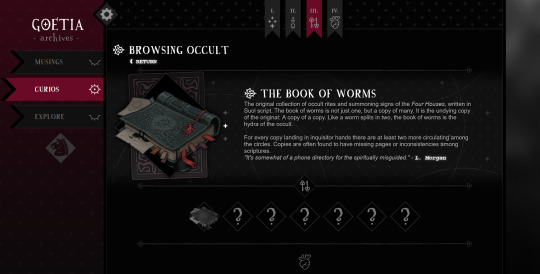


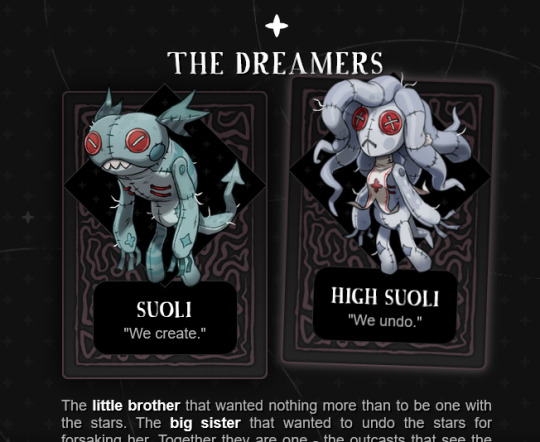

I have been super busy making a little browser game with our worldbuilding. It's an experimental detective adventure... I'm sorta locking in where I'm going with it lately and felt like sharing the little WIPs! It's mostly placeholder art and sketches... And there won't be full animations, but it's been fun to see the talk sprites do things, haha.
It's fully done in PHP/mySQL for the base framework, javascript and jquery. There's so much to do, to draw, to write. Prior to that I only knew how to do stuff on the front end, but I've been slooowly learning to code up stuff and it's been a really fun experience.
That said, it's extremely early in development since I'm still writing more functions and modules, and I barely wrote the intro, but the raw framework is already in place.
(edited my post a little because I long moved past the cookie string system I initially used %))
891 notes
·
View notes
Note
Hey why DO all those old tabletop RPGS and adventure games have such weird obtuse "act in this one scene or softlock forever" moments? Like, these weren't designed like arcade games that munch quarters... Why was this sort of thing so commonplace?
(With reference to this post here.)
Funnily enough, for tabletop RPGs there's actually a good answer.
If you're familiar with the popular history of tabletop roleplaying games, you've probably heard the idea that they developed out of fantasy wargaming. That's not actually terribly accurate; tabletop RPGs and fantasy wargames are more like two parallel branches that split off from the recreating-historical-battles kind of wargaming at about the same time, and for the first couple of decades there wasn't a bright line drawn between them like there is today. Many are genuinely hard to classify by contemporary standards – there are a lot of early fantasy wargames that look more like modern tabletop RPGs, and vice versa.
One of the consequences of that lack of sharp distinctions between tabletop RPGs and fantasy wargames is that early tabletop RPGs were often played in a sort of "competitive co-op" format at wargaming tournaments. Multiple groups would run their parties through the same adventure in parallel, and be ranked on their performance; sometimes this would involve scoring points for completing specific objectives, or speedrunning the adventure and aiming for the fastest time, but the most popular tournament format was the survival module: adventures which were deliberately designed to be unreasonably difficult, with whichever group's last surviving character's corpse hit the ground furthest from the dungeon entrance being judged the winner.
The upshot of that popularity is that many published adventures early on – and certainly the greater part of the more infamous ones! – were originally written as survival modules, created to be run competitively at a particular tournament, and later repackaged and sold as commercial products. Of course, practically none of them actually explained that; like nearly all tabletop RPG material of their day, they were written under the assumption that all tabletop roleplayers had come up through organised play at university gaming clubs, and thus already had all the context I've just outlined. This ended up causing no end of confusion when the hobby's mainstream visibility exploded in the early 1980s, and suddenly there were folks who'd picked up the rulebooks at their local bookstores trying to teach themselves how to play from first principles with no prior contact with gaming club culture.
As for why adventure games were also like that... well, this is going to sound bizarre by contemporary standards, and I don't blame you if you don't believe me, but once upon a time, point-and-click adventure games were considered the gold standard for Serious Gaming. Unforgiving routing, bizarre moon-logic puzzles, and a bewildering variety of unique ways to get yourself killed off were held up as the mark of the serious gamer in much the same way that janky soulslike combat systems are today, and a large chunk of the genre was made to cater to that ethos. Gamer culture is a hell of a drug!
(If you're about to ask the obvious follow-up question, "what changed?", the point-and-click adventure game's fall from grace and subsequent dismissal as casual fluff tracks more or less directly with a large demographic shift in the late 1990s that saw the genre's player base skewing predominantly female – and, well, you can probably connect the dots from there.)
#gaming#tabletop roleplaying#tabletop rpgs#video games#game design#adventure games#violence mention#death mention#sexism mention#swearing
1K notes
·
View notes
Photo

#Temple #eServices #module under #integrated #Temple #management #system in #TamilNadu has been #developed by @NICMeitY & #facilitates #citizens to #book various temple #Services #Online #DigitalTransformation #DigitalMarketing #influencers #SocialMedia #Hindus #5G #construction https://www.instagram.com/p/CdyAFt-pGWOTcA0H6Br4ranqq-gvzZLa7ujDqQ0/?igshid=NGJjMDIxMWI=
#temple#eservices#module#integrated#management#system#tamilnadu#developed#facilitates#citizens#book#services#online#digitaltransformation#digitalmarketing#influencers#socialmedia#hindus#5g#construction
0 notes
Text
Space Station Concepts: Space Operations Center
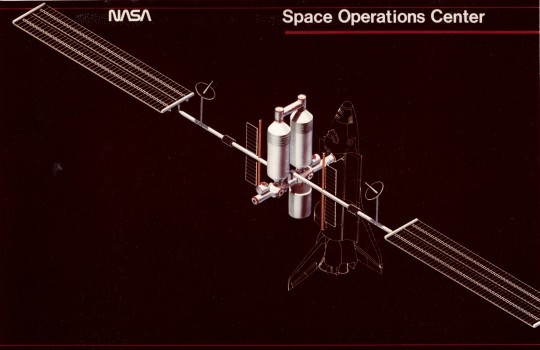

"The SOC is a self-contained orbital facility built up of several Shuttle-launched modules. With resupply, on-orbit refurbish- ment and orbit maintenance, it is capable of continuous operation for an indefinite period. In the nominal operational mode, the SOC is manned continuously, but unmanned operation is possible.

The present mission management and control process is characterized by a people-intensive ground monitoring and control operation involving large supporting ground information and control facilities and a highly- integrated ground-flight crew operation. In order to reduce dependence on Earth monitoring and control, the SOC would have to provide for increased systems monitoring; fault isolation and failure analysis, and the ability to store and call up extensive sets of data to support the onboard control of the vehicle; and the onboard capability for daily mission and other activity planning."



"Like most other space station studies from the mid/late 1970s its primary mission was the assembly and servicing of large spacecraft in Earth orbit -- not science. NASA/JSC signed a contract with Boeing in 1980 to further develop the design. Like most NASA space station plans, SOC would be assembled in orbit from modules launched on the Space Shuttle. The crew's tour of duty would have been 90 days. NASA originally estimated the total cost to be $2.7 billion, but the estimated cost had increased to $4.7 billion by 1981. SOC would have been operational by 1990.

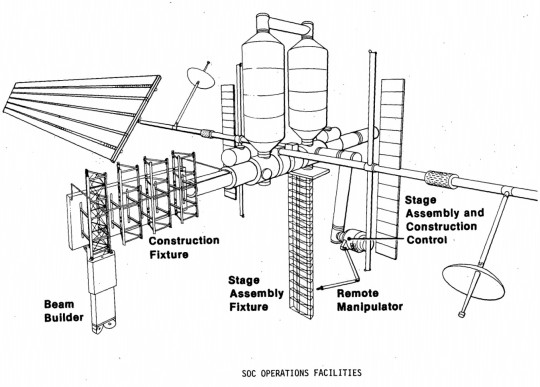

NASA's Johnson Spaceflight Center extended the Boeing contract in February 1982 to study a cheaper, modular, evolutionary approach to assembling the Space Operations Center. An initial power module would consist of solar arrays and radiators. The next launches would have delivered a space tug 'garage', two pressurized crew modules and a logistics module. The completed Space Operations Center also would have contained a satellite servicing and assembly facility and several laboratory modules. Even with this revised approach, however, the cost of the SOC program had grown to $9 billion. Another problem was Space Operations Center's primary mission: spacecraft assembly and servicing. The likely users (commercial satellite operators and telecommunications companies) were not really interested in the kind of large geostationary space platforms proposed by NASA. By 1983, the only enthusiastic users for NASA's space station plans were scientists working in the fields of microgravity research and life sciences. Their needs would dictate future space station design although NASA's 1984 station plans did incorporate a SOC-type spacecraft servicing facility as well."
Article by Marcus Lindroos, from astronautix.com: link

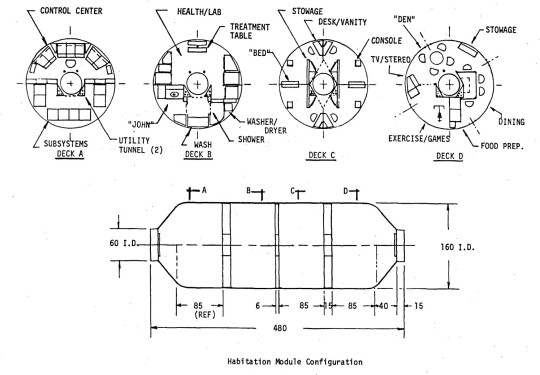


NASA ID: link, S79-10137
Boeing photo no. R-1859, link, link
#Space Operations Center#Space Station Freedom#Space Station Concept#Space Station#Concept Art#Space Station Program#Space#Earth#Space Shuttle#Orbiter#NASA#Space Shuttle Program#1979#1980s#my post
440 notes
·
View notes
